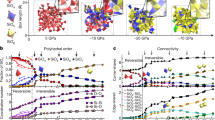Abstract
The structural transformation of Silica system under compression at glass transition temperature (1475 K) investigated by molecular dynamics method. The structural features such as pair radial distribution function, coordination number, linkage and cluster distribution analyzed systematically. The tetrahedral coordination (SiO4) maintained up to pressure of 5 GPa. Under compression, the structure tends to transit gradually from tetrahedral- to octahedral- coordination (SiO6) via pentahedral ones (SiO5). At pressure beyond 30 GPa, most of Si cation have octahedral coordination. The structural transitions at high-temperature models (1475 K) occurred at pressure higher than that at low temperature ones (500 K). In the 10–20 GPa range, the structure of model consisted of two large clusters of SiO5 and SiO6 revealing the structural homogeneity.
Similar content being viewed by others
Data Availability
The data that support the findings of this study are available from the corresponding author upon reasonable request.
References
Du T, Søren S, Theany T, Morten MS (2022) Oxide glasses under pressure: Recent insights from experiments and simulations. J Appl Phys 131:170901
Zarzycki J (1982) Glasses and the Vitreous State. Cambridge University Press, Cambridge, UK
Varshneya AK (2006) Fundamentals of Inorganic Glasses. Society of Glass Technology, Sheffield, UK
Dyre JC (2006) Colloquium: The glass transition and elastic models of glass-forming liquids. Rev Mod Phys 78:953–972
Kurkjian CR, Krol DM, Devine RB, Duraud JP, Dooryheé E (2000) Structure and Imperfections in Amorphous and Crystalline Silicon Dioxide. John Wiley and Sons, New York, 449
Klinger MI (2013) Glassy Disordered Systems: Glass Formation and Universal Anomalous Low-Energy Properties. World Scientific, London, UK
Sanditov DS, Ojovan MI, Darmaev MV (2020) Glass transition criterion and plastic deformation of glass. Physica B 582:411914
Tanaka H (2005) Two-order-parameter model of the liquid–glass transition. I. Relation between glass transition and crystallization. J Non-Cryst Solids 351:3371–3384
Nhan NT, Hung PK, Nghiep DM, Kim HS (2008) Molecular Dynamics Investigation on Microstructure and Void in Amorphous SiO2. Mater Trans 49:1212–1218
Vinh LT, Hung PK, Hong NV, Tu TT (2009) Local microstructure of silica glass. J Non-Cryst Solids 355:1215–1220
Nhan NT, Trang GTT, Iitaka T, Hong NV (2019) Crystallization of amorphous silica under compression. Can J Phys 97:1133–1139
Onodera et al (2020) Structure and properties of densified silica glass: characterizing the order within disorder. NPG Asia Mater 12:85
Preschera C, Vitali BP, Stefanski J, Jahn S, Lawrie BS, Wang Y (2017) Beyond sixfold coordinated Si in SiO2 glass at ultrahigh pressures. PNAS 114:10041–10046
Hong NV, Lan MT, Nhan NT, Hung PK (2013) Polyamorphism and origin of spatially heterogeneous dynamics in network-forming liquids under compression: Insight from visualization of molecular dynamics data. Appl Phys Lett 102:191908
Zeidler A, Salmon PS, Skinner LB (2014) Packing and the structural transformations in liquid and amorphous oxides from ambient to extreme conditions. Proc Natl Acad Sci 111:10045–10048
Salmon PS, Huang L (2017) Impact of pressure on the structure of glass and its material properties. MRS Bull 42:734–737
Ojovan MI, Tournier RF (2021) On Structural Rearrangements Near the Glass Transition Temperature in Amorphous Silica. Materials 14:5235
Van Beest BWH, Kramer GJ, van Santen RA (1990) Force fields for silicas and aluminophosphates based onab initiocalculations. Phys Rev Lett 64:1955–1958
Biswas RK, Khan P, Mukherjee S, Mukhopadhyay AK, Ghosh J, Muraleedharan K (2018) Study of short-range structure of amorphous Silica from PDF using Ag radiation in laboratory XRD system, RAMAN and NEXAFS. J Non-Cryst Solids 488:1–9
Vollmayr K, Kob W, Binder K (1996) Cooling-rate effects in amorphous silica: A computer-simulation study. Phys Rev B 54:15808–15827
Mozzi RL, Warren BE (1969) The structure of vitreous silica. J Appl Cryst 2:164–172
Inamura Y, Katayama Y, Utsumi W, Funakoshi K (2004) Transformations in the Intermediate-Range Structure of SiO2 Glass under High Pressure and Temperature. Phys Rev Let 93:015501
El’kin FS, Brazhkin VV, Khvostantsev LG, Tsiok OB, Lyapin AG (2002) In situ Study of the Mechanism of Formation of Pressure-Densified SiO2 Glasses. JETP Lett 75:342–347
Saika-Voivod I, Poole PH, Bowles RK (2006) Test of classical nucleation theory on deeply supercooled high-pressure simulated silica. J Chem Phys 124:224709
Hung PK, Nhan NT (2010) Polyamorphism in the silica glass. Scr Mater 63:12–15
Mauri F et al (2000) Si-O-Si bond-angle distribution in vitreous silica from first principles 29Si NMR analysis. Phys Rev B 62:4786–4789
Ivan S, Francesco S, Tor G, Peter HP (2004) Phase diagram of silica from computer simulation. Phys Rev E 70:061507
Sato T, Funamori N (2008) Sixfold-coordinated amorphous polymorph of SiO2 under high pressure. Phys Rev Lett 101:255502
Petitgirard S et al (2019) Magma properties at deep Earth’s conditions from electronic structure of silica. Geochem Persp Let 9:32–37
Author information
Authors and Affiliations
Contributions
Nguyen Thu Nhan: constructed models, analyzed, summarized, and written reports. Nguyen Van Hong: constructed models. Mai Thi Lan: analyzed and processed the data. All authors have read and agreed to the published version of the manuscript.
Corresponding author
Ethics declarations
Ethics Approval
Not applicable.
Consent to Participate
All authors have agreed to participate.
Informed Consent Statement
Not applicable.
Consent for Publication
All authors have agreed for publication.
Institutional Review Board Statement
Not applicable.
Conflicts of Interest
The authors declare that they have no conflict of interest.
Competing Interests
The authors declare no competing interests.
Additional information
Publisher's Note
Springer Nature remains neutral with regard to jurisdictional claims in published maps and institutional affiliations.
Rights and permissions
Springer Nature or its licensor (e.g. a society or other partner) holds exclusive rights to this article under a publishing agreement with the author(s) or other rightsholder(s); author self-archiving of the accepted manuscript version of this article is solely governed by the terms of such publishing agreement and applicable law.
About this article
Cite this article
Nhan, N.T., Van Hong, N. & Lan, M.T. Effect of Pressure on the Structure of SiO2 at the Glass Transition Temperature. Silicon 15, 4473–4480 (2023). https://doi.org/10.1007/s12633-023-02352-3
Received:
Accepted:
Published:
Issue Date:
DOI: https://doi.org/10.1007/s12633-023-02352-3




